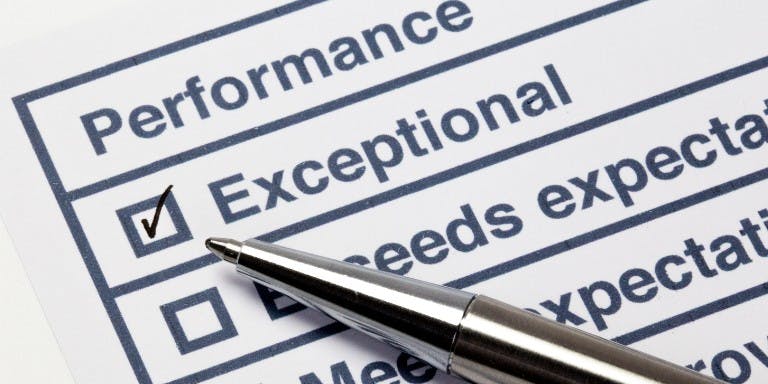First published on Thursday, May 4, 2023
Last updated on Thursday, February 27, 2025
Jump to section
- What is a performance development plan?
- How to create a performance development plan
- Why is performance development planning important?
- How to support the performance of your employees
- Is performance management a legal requirement?
- How often should you create a PDP?
- Centralise your performance management with BrightHR
Employee performance is key to the growth and success of your business. Without the professional development and quality output from your employees, it will be difficult to make progress. This is why good performance management software, and its many elements are so important to the management of your employees.
Performance development plans, also known as personal development plans, are one such tool managers can use to implement change and improve the performance of employees within your business. Don't confuse these with performance improvement plans (PIPs) though.
In this guide, we'll look at what a performance development plan is, what the benefits are, and how to create plans for your employees.
What is a performance development plan?
A performance development plan is a strategy that helps an employee reach their personal goals or overall work targets.
Performance development planning can help with:
Setting goals and objectives for individuals or entire teams
Creating an action plan (including a timeline) to help reach professional goals
Scheduling regular check-ins to review the process and provide feedback
Keeping their development planning process updated
Performance management and development is all about helping to improve employee performance and productivity. Managers can create a plan for an individual; or design strategies for an entire team or department to follow.
PDPs are typically formatted into a document that employees and managers can refer to when required. They can be written in collaboration with the employee and tailored to their own specific performance needs and professional growth objectives.
How to create a performance development plan
In order to create an efficient development plan for each one of your employees, you should cover the following areas:
Identify key goals
The first step managers should take is to identify key goals for the plan.
Each employee or team will require goals that are specific to their needs and level. Some might need to improve their communication skills with colleagues. Or, maybe you want to change your work strategies to achieve better performance expectations.
Managers should start by outlining set goals which highlight the overall direction and reason behind the development plan. Goal setting can also be used for both short and long-term objectives.
Decide on the structure
The next step is to decide how the development plan should be structured.
Managers may choose to outline one large goal, along with several smaller objectives. Or you can select goals which solely track progress.
When you create a development plan, make sure it's clear and transparent for your employee or team. The more tailored it is, the easier it'll be when executing them over time.
Set a deadline to review
Managers should then set a deadline to review the performance development plan.
A review process will help identify any issues within the plan, as well as encourage accountability for certain situations.
Set regular check-ins once per month for a quick overview. For example, managers can schedule a formal review date. This is usually known as a performance appraisal meeting or performance review. Meanwhile less formal one-to-one meetings can be carried out more often to ensure an employee is on track and happy with their goals.
Encourage collaboration between teams
In some cases, managers may need to reach goals for the overall business. It's best to encourage collaboration, so your staff can collectively strive towards team goals.
Employees can help each other to track progress for shared objectives. This helps develop employee engagement, motivation, and overall professionalism.
By encouraging collaboration, you'll be able to establish an action plan that accelerates business productivity and success.
Make adjustments to support progress
There might be times where managers notice a team-member is struggling with a certain goal or even their overall objectives.
If you find the process isn't working well, make adjustments to support them. Look at your employees' progress to identify opportunities for any changes. With the right support, their achievements will transition into consistent effort and output.
It might take time to identify what the best action plan is. But overtime, you'll be able to incorporate strategies that work best with your team.
Keep improving performance management and development plans
The last step managers need to consider is to keep improving your performance development plans.
Performance management and development is supposed to include finding issues and resolving them to help further an employee's personal progress.
If employees reach their set goals, don't just stop there. Create a new goal for them to keep motivated and enthusiastic when it comes to work development. Afterall this is all part of the performance management cycle, which is a continuous, ongoing process to enhance employee output and business growth.
Why is performance development planning important?
Effective performance management and development doesn't just help with manifesting your business objectives. It also helps employees who are struggling to meet individual goals or work expectations.
Let's look at why creating a performance development plan is important for businesses:
Sets clear expectations
Performance development planning allows employees to understand what is expected from them (in relation to their job). It facilitates employee engagement because they become aware of how to work productively and efficiently.
These plans also help remove any confusion when it comes to individual or team targets. And they offer feedback on improving employee performance.
Professional development
Performance plans help employees grow their own professional development goals. They make it easier to track progress and develop skills whilst in their current job.
Performance management and development is also useful when structuring business practices to help employees in specific roles; or those who may need direction with career development.
Future growth
Performance management and development doesn't just help employees in their current role. It also supports future opportunities for them.
Employees can acknowledge how to focus on reaching these goals—allowing them to grow their personal skills and knowledge.
Performance reviews
PDPs support your performance reviews, giving you a clear understanding of what the employee has been doing over the past 6 months or year and which goals they have been able to achieve.
You can also develop a new PDP with each annual or biannual appraisal, ensuring that employees are regularly given new goals and opportunities to work towards.
How to support the performance of your employees
As well as implementing a performance development plan, you should provide support to your employees throughout this process. From offering training opportunities to professional growth and development resources, your employees will feel supported and empowered at work knowing they have the support they need to grow and develop.
Different performance development activities include:
Provide available resources for new projects
Introduce workshops and seminars
Offer additional training and certification courses
Provide mentoring and volunteering
Each activity provides employees with endless opportunities to achieve new skills and knowledge. From here, they're able to perform better in their current position or work their way up the business ladder.
Is performance management a legal requirement?
No, there is no law or statutory step-by-step guide on performance management processes.
But you and your business may face the consequences if you do choose to ignore its importance within the workplace:
Employees won't know what their personal or business objectives are
Managers won't be able to measure out key performance indicators (KPIs) properly
Managers aren't fully aware of what an employee wants from their role or position within the business
Businesses will have an inconsistent record (or no record) of employee evaluations and progress
How often should you create a PDP?
There's no legal timeframe on how often you should create a PDP. However, there are certain steps you should take to achieve the best outcome from them.
Managers can create a brand-new performance development plan when a new employee joins the business. Think about making them within the first three months of employment.
Plans should ideally document an employee's everyday progress. So, make sure you review and update them on a regular basis.
For example, a manager can hold a short, informal review once a month; and then hold a formal review meeting every six months. New PDPs can then be created once an employee has demonstrated growth and performance improvements.
Centralise your performance management with BrightHR
There are so many factors involved in performance development. But that doesn't mean you should ignore the benefits a PDP comes with.
Every line-manager should provide fair and accurate performance development plans for their staff. If you don't, you may end up losing talented employees and even stalling their personal development.
With BrightHR you can centralise your performance management processes, from documenting PDPs and PIPs, to setting goals, tracking progress, and gathering performance metrics. Our performance management software provides you an all-in-one view of employee performance in your workplace.
Book your free demo today to discover how a digital performance management system works and how HR software can enhance your people management.











